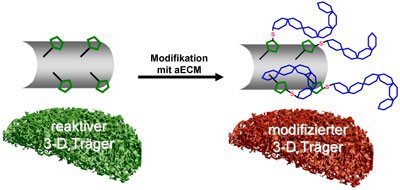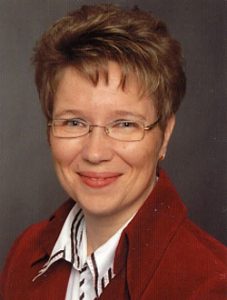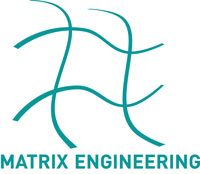
A1 – Dreidimensionale ECM-Polymer Hybridmatrizes zur Charakterisierung aEZM-Bestandteile
Im Rahmen des Teilprojekts A1 werden Makromonomere als Bausteine für bioabbaubare, quervernetzte, reaktive Trägersysteme zur Modifikation mit artifiziellen extrazellulären Matrizes (aECM) synthetisiert. Hierfür werden eine Reihe von bioabbaubaren Makromonomeren mit unterschiedlicher Hydrophilie, Abbaubarkeit und Reaktivität hergestellt und charakterisiert.
Durch Quervernetzung der Makromonomere werden 2- und 3-dimensionale (2-D und 3-D) polymere Trägersysteme mit einer variablen Dichte reaktiver Gruppen, kontrollierter Bioabbaubarkeit, mechanischer Stabilität und unterschiedlichem Quellungsvermögen hergestellt. Im Falle der makroporösen 3-D Träger (Scaffolds) sollen neben der chemischen Zusammensetzung auch Porengröße, Porenstruktur und Porosität der Träger durch das Herstellungsverfahren kontrolliert werden. Es sollen 3-D Matrizes identifiziert werden, die aufgrund ihrer Struktur, chemischen Zusammensetzung, mechanischer Eigenschaften, Biokompatibilität und Bioabbaubarkeit am besten für die jeweiligen in vitro und in vivo Wundheilungsmodelle für Haut und Knochen geeignet sind.
Im Anschluss ist die chemische Modifikation der Trägersysteme mit aECM-Molekülen geplant. Die daraus resultierenden Hybridsysteme sollen mit chemisch-analytischen Methoden und in der Zellkultur charakterisiert werden, insbesondere in Bezug auf Biokompatibilität und Interaktionen mit Zelllinien. Außerdem sollen Interaktionen mit verschiedenen, für Wundheilungsvorgänge relevanten Wachstumsfaktoren (TGF-ß1, BMP-2) in 2-D und 3-D untersucht werden.

Publikationen
- Krieghoff J, Gronbach M, Schulz-Siegmund M, Hacker MC. Biodegradable macromers for implant bulk and surface engineering. Biological Chemistry, vol. 402, no. 11, 2021, pp. 1357-1374. https://doi.org/10.1515/hsz-2021-0161.
- Krieghoff J, Kascholke C, Loth R, Starke A, Koenig A, Schulz-Siegmund M, Hacker MC. Composition-controlled degradation behavior of macroporous scaffolds from three-armed biodegradable macromers. Polymer Degradation and Stability 2021. https://doi.org/10.1016/j.polymdegradstab.2021.109775.
- Nawaz HA, Schröck K, Schmid M, Krieghoff J, Maqsood I, Kascholke C, Kohn-Polster C, Schulz-Siegmund M, Hacker MC. Injectable oligomer-cross-linked gelatine hydrogels via anhydride-amine-conjugation. Journal of Materials Chemistry B 2021; 9, 2295-2307, https://doi.org/10.1039/D0TB02861D.
- Krieghoff J, Rost J, Kohn-Polster C, Müller B, Koenig A, Flath T, Schulz-Siegmund M, Schulze FP, Hacker M. Extrusion-Printing of Multi-Channeled Two-Component Hydrogel Constructs from Gelatinous Peptides and Anhydride-Containing Oligomers. Biomedicines 2021, 9, 370, doi:10.3390/biomedicines9040370.
- Gronbach M, Mitrach F, Lidzba V, Müller B, Möller S, Rother S, Salbach-Hirsch J, Hofbauer LC, Schnabelrauch M, Hintze V, Hacker MC, Schulz-Siegmund M. Scavenging of Dickkopf-1 by macromer-based biomaterials covalently decorated with sulfated hyaluronan displays pro-osteogenic effects. Acta Biomater. 2020 Sep 15;114:76-89. doi: 10.1016/j.actbio.2020.07.017. Epub 2020 Jul 13. PMID: 32673749.
- Krieghoff J, Picke AK, Salbach-Hirsch J, Rother S, Heinemann C, Bernhardt R, Kascholke C, Möller S, Rauner M, Schnabelrauch M, Hintze V, Scharnweber D, Schulz-Siegmund M, Hacker MC, Hofbauer LC, Hofbauer C. Increased pore size of scaffolds improves coating efficiency with sulfated hyaluronan and mineralization capacity of osteoblasts. Biomater Res. 2019; 23:26. doi: 10.1186/s40824-019-0172-z.
- Kascholke C, Loth T, Kohn-Polster C, Möller S, Bellstedt P, Schulz-Siegmund M, Schnabelrauch M, Hacker M. Dual-functional hydrazide-reactive and anhydride containing oligomeric hydrogel building blocks. Biomacromolecules. 2017, 18:683-694.
- Kohn-Polster C, Bhatmagar D, Woloszyn DJ, Richtmyer M, Strake A, Springwald AH, Franz S, Schulz-Siegmund M, Kaplan HM, Kohn J, Hacker MC. Dual-Component Gelatinous Peptide/Reactive Oligomer Formulations as Conduit Material and Luminal Filler for Peripheral Nerve Regeneration. Int J Mol Sci. 2017 May 21;18(5).
- Müller BM, Loth R, Hoffmeister PG, Zühl F, Kalbitzer L, Hacker MC, Schulz-Siegmund M. Surface modification of copolymerized films from three-armed biodegradable macromers – an analytical platform for modified tissue engineering scaffolds. Acta Biomater. 2017, 51:148-160.
- Sülflow K, Schneider M, Loth T, Kascholke C, Schulz-Siegmund M, Hacker MC, Simon JC, Savkovic V. Melanocytes from the outer root sheath of human hair and epidermal melanocytes display improved melanotic features in the niche provided by cGEL, oligomer-cross-linked gelatin-based hydrogel. J Biomed Mater Res A. 2016;104:3115-26.
- Picke AK, Salbach-Hirsch J, Hintze V, Rother S, Rauner M, Kascholke C, Möller S, Bernhardt R, Rammelt S, Pisabarro MT, Ruiz-Gómez G, Schnabelrauch M, Schulz-Siegmund M, Hacker MC, Scharnweber D, Hofbauer C, Hofbauer LC. Sulfated hyaluronan improves bone regeneration of diabetic rats by binding sclerostin and enhancing osteoblast function. Biomaterials. 2016;96:11-23.
- Sedaghati B, Jahroomishirazi R, Starke A, Hacker MC, Schulz-Siegmund M. Rat osteosarcoma cells as a therapeutic target model for osteoregeneration via sclerostin knockdown. Cells Tissues Organs. 2016;201:366-79.
- Hendrikx S, Kascholke C, Flath T, Schumann D, Gressenbuch M, Schulze FP, Hacker MC, Schulz-Siegmund M. Indirect rapid prototyping of sol-gel hybrid glass scaffolds for bone regen-eration – Effects of organic crosslinker valence, content and molecular weight on mechanical properties. Acta Biomater. 2016;5:318-29.
- Loth R, Loth T, Schwabe K, Bernhardt R, Schulz-Siegmund M, Hacker MC. Highly adjustable biomaterial networks from three-armed biodegradable macromers. Acta Biomater. 2015;26:82-96.
- Loth T, Hötzel R, Kascholke C, Anderegg U, Schulz-Siegmund M, Hacker MC. Gelatin-based biomaterial engineering with anhydride-containing oligomeric cross-linkers. Biomacromoleculares 2014, 15, 2104-2118
- van der Smissen A, Hoffmeister PG, Friedrich N, Watarai A, Hacker MC, Schulz-Siegmund M, Anderegg U. Artificial extracellular matrices support cell growth and matrix synthesis of hu-man dermal fibroblasts in macroporous 3D scaffolds. J Tissue Eng Regen Med. 2015;25:56-75.
- Steinhagen M, Hoffmeister PG, Nordsieck K, Hötzel R, Baumann L, Hacker MC, Schulz-Siegmund M, Beck-Sickinger AG. Matrix metalloproteinase 9 (MMP-9) mediated release of MMP-9 resistant stromal cell-derived factor 1? (SDF-1?) from surface modified polymer films. ACS Appl Mater Interfaces. 2014;6:5891-9.
- Schneider H, Sedaghati B, Naumann A, Hacker MC, Schulz-Siegmund M. Gene silencing of chordin improves BMP-2 effects on osteogenic differentiation of human adipose tissue-derived stromal cells. Tissue Eng Part A. 2014;20:335-45.
- Loth T, Hennig R, Kascholke C, Hötzel R, Hacker MC. Reactive and stimuli-responsive maleic anhydride containing macromers – multi-functional cross-linkers and building blocks for hydrogel fabrication. React Funct Polym. 2013;73:1480-92.
- Schneider H, Sedaghati B, Naumann A, Hacker MC, Schulz-Siegmund M. Gene silencing of chordin improves BMP-2 effects on osteogenic differentiation of human adipose tissue derived stromal cells. Tissue Eng Part A. 2013.
- Loth T, Hennig R, Kascholke C, Hötzel R, Hacker MC. Reactive and stimuli-responsive maleic anhydride containing macromers – multi-functional cross-linkers and building blocks for hydrogel fabrication. React.Func.Polym. 2013;008,002
- Penk A, Förster Y, Scheidt HA, Nimptsch A, Hacker M, Schulz-Siegmund M, Ahnert P, Schiller J, Rammelt S, Huster D. The pore size of PLGA bone implants determines the de novo formation of bone tissue in tibial head defects in rats. Magn Resonan Med. 2013;70:925-35.
- Hassert R, Hoffmeister PG, Pagel M, Hacker M, Schulz-Siegmund M, Beck-Sickinger AG. On-resin synthesis of an acylated and fluorescence-labeled cyclic integrin ligand for modification of poly-(lactid-coglycolic-acid). Chem Biodivers. 2012;9:2648-58.
- Ambrosch K, Manhardt M, Loth T, Bernhardt R, Schulz-Siegmund M, Hacker MC. Open porous microscaffolds for cellular and tissue engineering by lipid templating. Acta Biomaterialia. 2012; 8. 1303-15.
- Hoyer J, Schatzschneider U, Schulz-Siegmund M, Neundorf I. Dimerization of a cell-penetrating peptide leads to enhanced cellular uptake and drug delivery. Beilstein J Org Chem. 2012;8:1788-97.
- Böhme J, Anderegg U, Nimptsch A, Nimptsch K, Hacker M, Schulz-Siegmund M, Huster D, Schiller J. De novo biosynthesis of GAG in the extracellular matrix of skin studied by MALDI MS. Anal Biochem. 2012;421:791-3.
- Weber F, Böhme J, Scheidt HA, Gründer W, Rammelt S, Hacker M, Schulz-Siegmund M, Huster D. 31P and 13C solid state NMR spectroscopy to study collagen synthesis and biomineralization in polymer-based bone implants. NMR Biomed. 2012;25:464-75.
- Klouda L, Hacker MC, Kretlow JD, Mikos AG. Cytocompatibility evaluation of amphiphilic, thermally responsive and chemically crosslinkable macromers for in situ forming hydrogels. Biomaterials. 2009;30:4558-66.
- Hacker MC, Klouda L, Ma BB, Kretlow JD, Mikos AG. Synthesis and characterization of injectable, thermally and chemically gelable, amphiphilic poly(N-isopropylacrylamide)-based macromers. Biomacromolecules. 2008;9:1558-70.
- Hacker M, Ringhofer M, Appel B, Neubauer M, Vogel T, Young S, Mikos AG, Blunk T, Gopferich A, Schulz MB. Solid lipid templating of macroporous tissue engineering scaffolds. Biomaterials. 2007;28:3497-507.
- Lieb E, Hacker M, Tessmar J, Kunz-Schughart LA, Fiedler J, Dahmen C, Hersel U, Kessler H, Schulz MB, Gopferich A. Mediating specific cell adhesion to low-adhesive diblock copolymers by instant modification with cyclic RGD peptides. Biomaterials.2005;26:2333-41.
- Lieb E, Milz S, Vogel T, Hacker M, Dauner M, Schulz MB. Effects of transforming growth factor beta1 on bonelike tissue formation in three-dimensional cell culture. I. Culture conditions and tissue formation. Tissue Eng. 2004;10:1399-413.
- Lieb E, Tessmar J, Hacker M, Fischbach C, Rose D, Blunk T, Mikos AG, Gopferich A, Schulz MB. Poly(D,L-lactic acid)-poly(ethylene glycol)-monomethyl ether diblock copolymers control adhesion and osteoblastic differentiation of marrow stromal cells. Tissue Eng. 2003;9:71-84.
- Hacker M, Tessmar J, Neubauer M, Blaimer A, Blunk T, Gopferich A, Schulz MB. Towards biomimetic scaffolds: anhydrous scaffold fabrication from biodegradable amine-reactive diblock copolymers. Biomaterials.2003;24:4459-73.
Kontakt

Prof. Dr. rer.nat. Michaela Schulz-Siegmund
Professorin für Pharmazeutische Technologie
Medizinische Fakultät der Universität Leipzig
Institut für Pharmazie
Eilenburger Straße 15 A, 04317 Leipzig
Telefon: +49 (0)341 97-36600
E-Mail: schulz@rz.uni-leipzig.de
Web: pharmazie.medizin.uni-leipzig.de

Jun.-Prof. Dr. rer.nat. habil. Michael Hacker
Pharmazeutische Technologie
Medizinische Fakultät der Universität Leipzig
Institut für Pharmazie
Eilenburger Straße 15 A, 04317 Leipzig
Telefon: +49 (0)341 97-36602
E-Mail: mhacker@uni-leipzig.de
Web: pharmazie.medizin.uni-leipzig.de
und
Institut für Pharmazeutische Technologie und Biopharmazie
Heinrich-Heine-Universität Düsseldorf
Mathematisch-Naturwissenschaftliche Fakultät
Universitätsstraße 1
40225 Düsseldorf
Web: pharmazie.hhu.de
